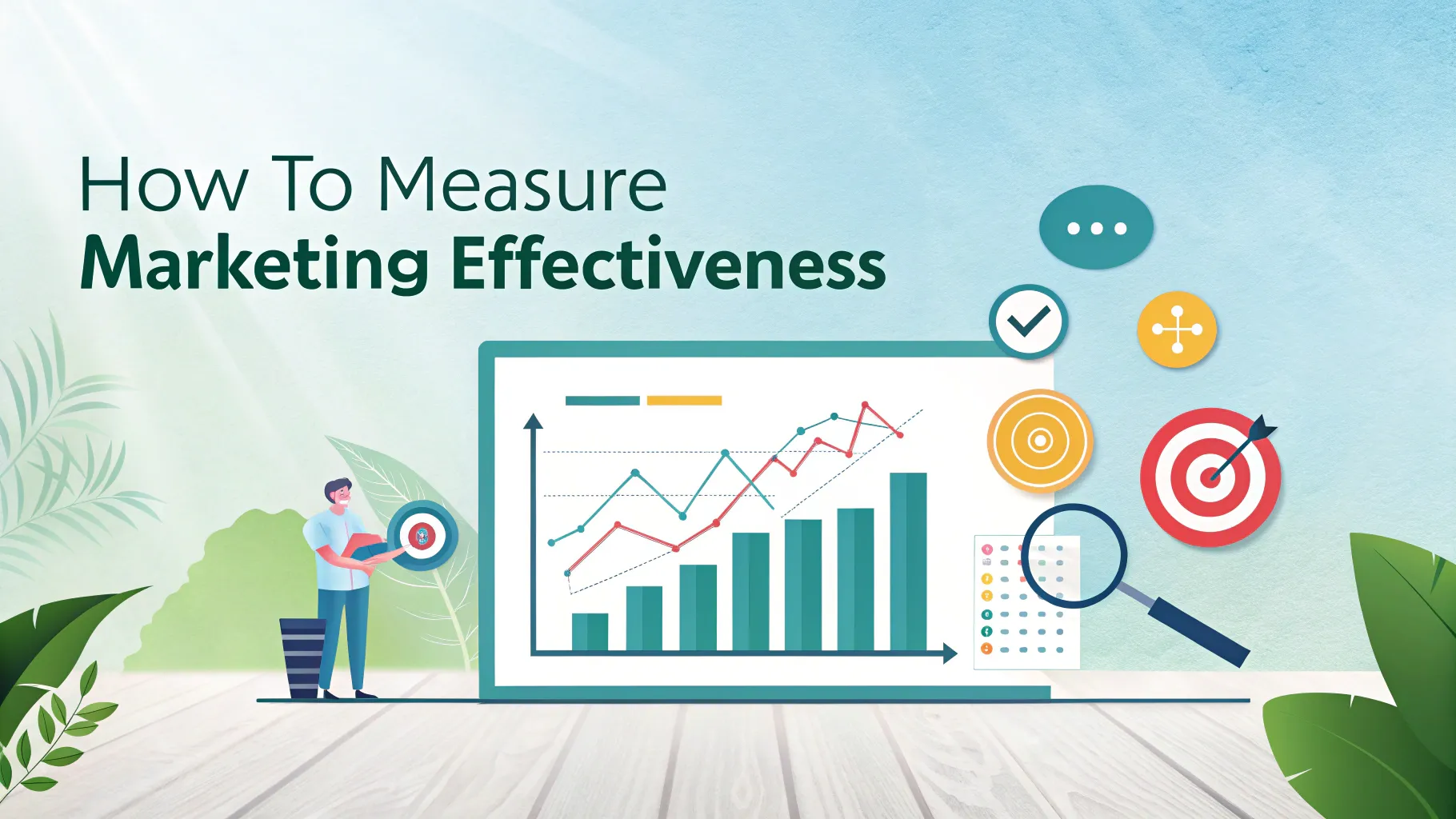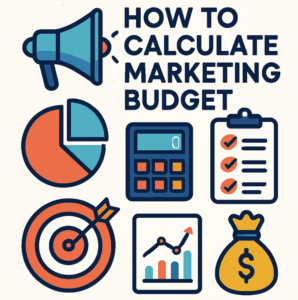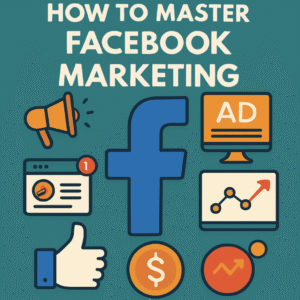
Marketing effectiveness determines how well strategies drive revenue growth while minimizing customer acquisition costs. It’s not just about spending money; it’s about spending wisely. Actionable metrics, like conversion rates or ROI, provide clear, measurable data to guide decisions and refine strategies.
For example, email marketing delivers an average ROI of $38 for every $1 spent, making it a powerful tool for businesses. Yet, only 60% of marketers feel confident proving their ROI. Measuring marketing effectiveness helps improve ROI, retain customers, and optimize campaigns. Once you know how to measure marketing effectiveness, it ensures every dollar works harder for your business.
Key Metrics to Measure Marketing Effectiveness
ROI (Return on Investment)
When I evaluate marketing efficiency, ROI is the first metric I consider. It tells me whether my campaigns are delivering more value than they cost. Calculating ROI is straightforward. Use this formula:
|
Calculation Method |
Formula |
Description |
|---|---|---|
|
Marketing ROI |
(Increased Sales – Marketing Spend) / Marketing Spend |
|
|
Return on Ad Spend (ROAS) |
Increased Sales / Marketing Spend |
A simplified calculation for quick comparisons within advertising platforms. |
For example, email marketing boasts an impressive ROI of $38 for every $1 spent. Compare that to paid search, which averages $2 for every $1 spent. Here’s a quick look at ROI benchmarks across channels:
|
Marketing Channel |
Average ROI |
|---|---|
|
SEO |
$22.24 for every $1 spent |
|
Paid Search (Google Ads) |
$2 for every $1 spent |
|
E-commerce (Email) |
$38 for every $1 spent |
|
Influencer Marketing |
$5.20 for every $1 spent |
Understanding these benchmarks helps me allocate budgets wisely and focus on high-performing channels.
Conversion Rates
A strong conversion rate is a clear sign of marketing efficiency. It shows how well my campaigns turn visitors into customers. Conversion rates vary by channel and industry. For instance:
|
Channel |
Average Conversion Rate |
Industry Variations |
|---|---|---|
|
Organic Search |
B2C: 2.1%, B2B: 2.6% |
|
|
Paid Search |
2% – 3% |
B2C: 1.2%, B2B: 1.5% |
|
Email Marketing |
2% – 5% |
Context-dependent |
Factors like user experience, ad relevance, and clear messaging significantly impact conversion rates. I always ensure my campaigns deliver a seamless experience and resonate with the target audience.
Customer Lifetime Value (CLV)
CLV measures the total revenue a customer generates during their relationship with a business. It’s a critical key performance indicator for long-term success. Industries like software and healthcare consultancy report average CLVs of $240,000 and $330,000, respectively.
|
Industry |
Average CLV |
|---|---|
|
Software company |
$240,000 |
|
Healthcare consultancy |
$330,000 |
|
Business consultancy |
$385,000 |
Improving CLV has a profound impact on profitability. A 5% increase in customer retention can boost profits by 25% to 95%. I focus on retaining customers through personalized experiences and consistent value delivery. This approach not only enhances CLV but also strengthens brand loyalty.
Social Media Engagement
Social media engagement is one of the most telling indicators of how well a brand connects with its audience. I always look at several key metrics to measure this. First, I track reach, which shows the number of unique viewers who see my content. Impressions, on the other hand, reveal how many times my posts are viewed, even if by the same person. These numbers help me understand the visibility of my campaigns.
Engagement rate is another critical metric. It measures how actively my audience interacts with my posts through likes, comments, shares, and clicks. A high engagement rate often signals that my content resonates with my audience.
I also monitor follower growth rate to see how quickly my social media presence expands. This metric tells me whether my strategies are attracting new followers or if I need to adjust my approach.
I’ve seen how successful campaigns leverage these metrics to drive results. For example, the “Will It Blend?” campaign by Blendtec went viral by blending unusual items like smartphones. Millions of views and shares turned their product into a household name. Similarly, the Make-A-Wish “BatKid” campaign captured hearts worldwide, proving that emotional storytelling can amplify engagement.
Tracking conversion and clickthrough rates is equally important. These metrics show how effective my social media efforts are at driving actions, such as website visits or purchases.
When I analyze these numbers, I can refine my strategies to boost my overall conversion rate. Social media engagement isn’t just about numbers. It’s about building relationships and creating content that inspires action. By focusing on these metrics, I ensure my campaigns deliver meaningful results.
Website Traffic and Email Open Rates
Website traffic and email open rates are two foundational metrics I rely on to gauge marketing effectiveness. Website traffic gives me a clear picture of how well my campaigns drive visitors to my site.
I further analyze traffic sources—organic search, paid ads, social media, and email campaigns. This helps me identify which channels perform best.
Email open rates, on the other hand, measure how many recipients open my emails. A strong open rate often indicates that my subject lines and timing are on point. For instance, emails sent on Tuesdays between 10 a.m. and 2 p.m. tend to perform better, with average open rates hovering around 18%.
I also pay close attention to bounce rates and session durations on my website. A high bounce rate might mean my landing pages need improvement, while longer session durations suggest that visitors find my content engaging.
Combining these insights with email clickthrough rates allows me to optimize my campaigns for better results.
One strategy I’ve found effective is personalizing email content. Personalized emails can boost open rates by up to 26%. For example, including the recipient’s name in the subject line or tailoring content based on past behavior makes a significant difference.
Both website traffic and email open rates provide actionable insights. They help me understand what’s working and what needs adjustment. I ensure my marketing efforts consistently drive engagement and conversions by focusing on these metrics.
Setting Up Data Tracking and Analytics Tools
What You Need
To measure marketing efficiency effectively, I always start by identifying the right tools for data tracking and analysis. These tools help me monitor key performance indicators like website traffic, conversion rates, and ROI.
Choosing the right tools depends on your business goals and the metrics you want to track. For example, if I need to understand user behavior on my website, I use tools like Hotjar to visualize engagement.
For social media campaigns, Hootsuite provides detailed insights into reach, engagement, and conversions.
I also ensure my tools align with my marketing objectives. For instance, if my goal is to improve email open rates, I rely on platforms like HubSpot to track campaign performance. Using a combination of tools gives me a holistic view of my marketing efforts, ensuring no data point gets overlooked.
Tools to Use
Google Analytics
Google Analytics is my go-to tool for tracking website performance. It provides detailed insights into visitor behavior, traffic sources, and conversion paths. I use it to identify which channels drive the most traffic and where users drop off during their journey.
This data helps me optimize my campaigns for better results.
CRM Systems (e.g., Salesforce, HubSpot)
CRM systems like Salesforce and HubSpot are essential for managing customer relationships. They allow me to track leads, monitor sales pipelines, and measure campaign effectiveness.
These platforms also integrate seamlessly with other tools, ensuring smooth data flow across channels.
Marketing Automation Platforms (e.g., Marketo, Mailchimp)
Marketing automation platforms streamline repetitive tasks like email marketing and lead nurturing. I use tools like Marketo and Mailchimp to automate workflows, segment audiences, and personalize content.
These platforms also provide detailed analytics, helping me refine my strategies based on performance data.
How to Integrate Tools with Marketing Channels
Integrating analytics tools with marketing channels is crucial for accurate data tracking and analysis. I follow a step-by-step approach to ensure seamless integration:
-
Assess marketing needs and goals to determine the right tools.
-
Implement tracking codes and pixels on websites and landing pages.
-
Customize dashboards to display relevant metrics for each campaign.
-
Use tools like Hootsuite to connect social media accounts and track engagement.
-
Automate multi-touch campaigns with platforms like Marketo for consistent messaging.
For example, when I aim to increase social media engagement, I integrate Hootsuite with my accounts to monitor likes, comments, and shares. This setup allows me to make data-driven decisions and improve marketing efficiency.
Step-by-Step Guide to Measuring Marketing Effectiveness
Define Clear Objectives and Goals
Setting clear objectives is the foundation of marketing efficiency. I always start by aligning my goals with measurable outcomes. For example, if I want to improve brand reputation, I aim for a 90% positive share of voice by the end of the year.
If increasing revenue is my focus, I might plan to launch four new products within the fiscal year.
Here’s a table of common goals and their corresponding objectives:
|
Goal |
Example Objective |
|---|---|
|
Improve Brand Reputation |
Gain and retain a 90% positive share of voice by the end of the calendar year. |
|
Increase Brand Presence |
Publish 4 articles monthly on external sources our target audience follows. |
|
Retain Existing Customers |
Reduce bugs to zero for every feature launch to decrease churn to 3% by Q4. |
|
Increase Revenue |
Launch 4 new products by the end of the fiscal year. |
To ensure these objectives are actionable, I use the SMART model. This approach keeps goals specific, measurable, achievable, relevant, and time-bound. I also communicate these goals clearly with my team to maintain alignment and track progress effectively.
Collect and Organize Data from All Channels
Gathering data from multiple channels is essential for measuring marketing effectiveness. I rely on tools like Airtable to create interactive spreadsheets that organize data efficiently.
For seamless integration across platforms, I often use private APIs. This method ensures all my data flows into one central system, making analysis easier.
Focusing on key performance indicators like conversion rates and website visits helps me streamline the process. I also segment data based on customer attributes such as location or engagement levels. This segmentation allows me to personalize campaigns and improve marketing efficiency.
Analyze Metrics to Identify Trends and Patterns
Once I’ve collected the data, I dive into analysis to uncover trends and patterns. I look for spikes in website traffic or dips in email open rates to understand what’s working and what isn’t.
For example, if I notice a high bounce rate on a landing page, I investigate the content or design to identify issues.
Tracking metrics over time reveals valuable insights. I compare performance across campaigns to pinpoint strengths and weaknesses. This analysis helps me refine strategies and allocate resources to high-performing channels. Focusing on actionable insights ensures my marketing efforts consistently drive results.
Evaluate Campaign Strengths and Weaknesses
Evaluating campaign strengths and weaknesses is essential for improving marketing efficiency. I always start by identifying what worked well and what didn’t. This process helps me uncover actionable insights that guide my next steps.
For example, I analyze customer segmentation to see if my campaigns effectively targeted specific groups. Tailoring strategies to these segments often boosts engagement and conversions.
Another method I use is A/B testing. Testing different versions of ads, emails, or landing pages reveals which elements resonate most with my audience. For instance, I once tested two email subject lines—one personalized and one generic.
The personalized version achieved a 26% higher open rate. This insight helped me refine future email campaigns.
I also rely on sales funnel analysis to pinpoint where prospects drop off. If I notice a high drop-off rate at the consideration stage, I revisit my messaging or offer to address potential objections. Sentiment analysis is another powerful tool. Monitoring customer feedback and social media mentions helps me gauge public perception.
When sentiment skews negative, I act quickly to address concerns and protect my brand reputation.
Churn analysis is equally important. Understanding why customers leave allows me to implement retention strategies, such as loyalty programs or personalized follow-ups. These evaluations ensure my campaigns consistently improve over time.
Use Insights to Make Data-Driven Decisions
Once I’ve evaluated my campaigns, I use the insights to make data-driven decisions. This approach ensures every action I take is backed by evidence, not guesswork. For example, predictive analytics helps me forecast future trends based on historical data. If I see that a particular product category spikes in demand during the holiday season, I allocate more budget to promote it.
Customer journey mapping is another strategy I use. Identifying pain points in the customer experience allows me to address them proactively.
For instance, if I notice that customers abandon their carts due to high shipping costs, I test offering free shipping for orders over a certain amount. This small change often leads to a significant increase in conversions.
I also prioritize optimizing marketing efficiency by focusing on high-performing channels. If website traffic from organic search consistently outperforms paid ads, I invest more in SEO. Similarly, I use churn analysis to refine retention strategies.
For example, offering exclusive discounts to at-risk customers has helped me reduce churn by 15% in past campaigns.
These insights not only improve individual campaigns but also enhance my overall strategy. Knowing how to measure marketing effectiveness ensures I allocate resources wisely and achieve better results.
Actionable Tips to Improve Marketing Effectiveness
Optimize Campaigns Based on Data Insights
I always start optimizing campaigns by diving into data insights. Understanding audience nuances through segmentation allows me to craft messages that resonate with different personas.
This approach ensures my campaigns connect with the right people at the right time. Here’s how I make data work for me:
-
Segment audiences to create targeted campaigns for specific groups.
-
Monitor performance metrics to quickly identify what works and what doesn’t.
-
Use A/B testing to determine the most effective variations of ads or emails.
-
Personalize customer experiences to boost engagement and revenue.
For example, I once applied real-time analytics to a campaign for a dental product. The result? A 10.8% sales lift and $245,000 in incremental sales. Immediate feedback from consumer actions allowed me to adjust strategies on the fly, ensuring every dollar spent delivered maximum impact.
Test and Refine Attribution Models
Attribution models help me understand which marketing efforts drive results. I use both single-touch and multi-touch models depending on the campaign.
For instance, first-touch attribution credits the initial interaction, while time decay models give more weight to recent touchpoints.
Refining these models can be challenging. Complex data, lack of standardization, and attribution bias often complicate the process. To overcome these hurdles, I focus on:
-
Simplifying data analysis to avoid overload.
-
Testing multiple models to find the best fit for my business.
-
Mapping consumer journeys to gain a clearer picture of interactions.
When done right, attribution models reveal the true drivers of marketing campaign success. This insight helps me allocate resources effectively and improve marketing effectiveness across all channels.
Enhance Customer Experience Through Personalization
Personalization transforms how customers perceive a brand. I’ve seen companies like Walgreens streamline prescription pickups with in-store kiosks, creating a seamless experience.
Similarly, Coca-Cola’s personalized name-branded bottles sparked massive engagement and sales.
To personalize effectively, I follow these steps:
-
Define goals and customer segments to align efforts with business objectives.
-
Use first-party data to tailor experiences that feel relevant and authentic.
-
Leverage AI-driven tools to enhance personalization capabilities.
For example, I once implemented a loyalty program for frequent customers. Using digital data, I tailored offers and greetings, which significantly boosted satisfaction and retention.
Personalization isn’t just a strategy—it’s a necessity for building lasting relationships and driving revenue growth.
Avoid Common Mistakes (e.g., ignoring data quality, over-relying on vanity metrics)
Mistakes can derail even the most well-planned marketing strategies. I’ve seen how ignoring data quality leads to poor decisions. Inaccurate or outdated data skews results, making it impossible to measure true performance. To avoid this, I always validate data sources and ensure regular updates.
Tools like data cleansing software help maintain accuracy and reliability.
Another common pitfall is over-relying on vanity metrics. Metrics like social media likes or website visits may look impressive but often fail to show real impact. I focus on actionable metrics like conversion rates and customer lifetime value instead.
These provide a clearer picture of how campaigns drive revenue and retention.
Failing to align metrics with business goals is another mistake I’ve encountered. For example, tracking email open rates without considering conversions misses the bigger picture. I always tie metrics to specific objectives, ensuring every data point contributes to improving marketing effectiveness.
Here’s a quick comparison of actionable vs. vanity metrics:
|
Metric Type |
Example Metrics |
Why It Matters |
|---|---|---|
|
Actionable Metrics |
Conversion Rates, ROI |
Directly linked to business goals. |
|
Vanity Metrics |
Likes, Impressions |
Often lack meaningful insights. |
Avoiding these mistakes ensures campaigns stay on track and deliver measurable results.
Overcome Potential Challenges (e.g., data silos, lack of resources)
Challenges like data silos and limited resources can hinder marketing success. Data silos occur when information is scattered across platforms, making it hard to get a unified view. I tackle this by integrating tools like CRMs and marketing automation platforms. These systems centralize data, making analysis seamless.
Limited resources, whether time, budget, or personnel, can also pose problems. I prioritize high-impact strategies to maximize efficiency. For instance, focusing on email marketing often yields better ROI than spreading resources thin across multiple channels.
Outsourcing tasks like content creation or analytics can also free up internal teams for strategic work.
Collaboration across departments helps overcome both challenges. Sharing insights between sales, marketing, and customer service teams ensures everyone works toward common goals. This alignment not only breaks down silos but also optimizes resource use.
Here’s how I address these challenges step-by-step:
-
Identify gaps in data integration and implement solutions like APIs.
-
Focus on high-performing channels to maximize ROI.
-
Foster cross-department collaboration to align efforts.
Overcoming these obstacles ensures campaigns run smoothly and deliver results that matter.
Actionable metrics are the backbone of successful marketing. They provide the clarity needed to refine strategies and achieve measurable results. I’ve shown how to measure marketing effectiveness by defining clear goals, tracking data, analyzing insights, and optimizing campaigns. These steps ensure every effort aligns with business objectives and delivers maximum impact.
Start implementing these strategies today. Use data to guide your decisions and watch your marketing performance soar. Measuring marketing effectiveness isn’t just a task—it’s the key to unlocking growth and achieving your goals.


